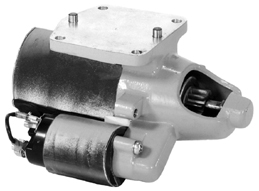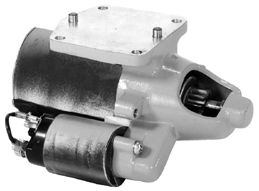
Sooner or later, every starter on a Lycoming engine will do it, intermittently at first then every time you try to start the engine.
Were talking about the failure of the Bendix drive to push the pinion out of its housing and into the flywheels ring gear. You hear the urgent whirrrrrrrrrr…but no engine cranking. Other than cursing and squirting some lube down into the drive, there’s not much you can do, although some owners will nurse the thing along by using a screwdriver to manually back the drive onto the ring gears teeth.
Long term, you’ll need to either rebuild or repair the drive or replace the starter. One option thats becoming increasingly popular is the lightweight starter, which follows modern automotive starter design, using a solenoid instead of the Bendix.
Besides being lighter, these starters crank the engine much faster and very probably will reduce cranking time. The tradeoff? Theyre expensive and may require some minor modifications in wiring and baffling to install. Heres an analysis of the pros and cons of lightweight starters.
Bendix Woes
In the arcane world of aircraft engine starters, there are two basic variants. The so-called Prestolite or Delco designs stem from older automotive hardware that are basically powerful DC motors. The Bendix drive lives at the front of the motor as a self-contained unit. When the starter motor spins , the drive pinion is pushed rapidly forward on spiral fluting machined into the motor shaft and then engages the flywheels teeth.
Once the engine starts and the flywheel spins up the starter, centrifugal force unlocks a couple of pawls and a spring forces the pinion off the ring gear and back into its housing.
All things considered, its not a bad system. But the drive lives in a harsh environment, exposed to dirt and the elements, which eventually corrode the flutes or fill them with oil and dirt. When that happens, the starter motor spins, but the Bendix cant force the pinion through all that gunk in the flutes so the gear wont engage. Eventually, you’ll have to rebuild the drive or replace the starter.
Lightweight Option
One replacement option is the so-called lightweight starter. Sky-Tec, Lamar, and Electrosystems/MagnaFlite are the primary manufacturers. Lightweights have two advantages over the old Delco/Prestolite designs: They weigh less and they crank faster.
The Lycoming TIO-540 operators manual lists the weight of a 24-volt Prestolite starter with Bendix drive at 16.9 pounds. Sky-Tecs replacement for the same starter, at 7.8 pounds, is less than half that of the original. Sky-Tec also has an HT (high torque) replacement at 10.4 pounds, which cuts 6.5 pounds off the originals weight.
With the lighter weight comes much faster cranking. Sky-Tec specs for its 95-amp 24- volt LS and PM models used on a Lycoming IO-540 crank the engine at 160 RPM. The 185-amp, 24-volt HT model, according to Sky-Tec, cranks at an astonishing 307 RPM.
Comparing these cranking speeds to the 60 to 80 RPM typically delivered by the IO-540s OEM unit, you can see the advantages. We recently replaced the Prestolite starter on Aviation Consumers Mooney with a Sky-Tec 149-12LS lightweight starter. Two things were immediately obvious: The cranking speed has doubled-at least-and starting effort is noticeably shorter, especially when the engine is hot.
How They Work
First, the motor itself and why its lighter than the older Prestolite designs. Traditional starter motors generate the required magnetic field with windings composed of lots of fine wire, yielding a dense field winding-both magnetically dense and materially dense-thats also heavy.
In most lightweight starters, the wound fields are replaced with powerful permanent magnets and instead of Bendix drives, the starter pinion is engaged with a dedicated solenoid, as in a modern car.
The solenoid is sealed and thus not susceptible to the dirt and corrosion problems that trouble Bendix drives. For other applications, these starters are marketed for use in harsh or corrosive environments precisely because theyre sealed against moisture and dirt. Sky-Tecs HT model is especially well-sealed with O-rings, and is marketed as such.
One note: Not all lightweight starters are built in the same way. Sky-Tecs HT Wound-Field models employ-as the name implies-wound, rather than permanent magnet fields, although they do have a solenoid engagement rather than a Bendix drive.
And the MagnaFlite and Lamar lightweight starters, while using permanent magnets , do retain Bendix drives. So these are best thought of as half-and-half designs. Faster cranking yes, but still having the Bendix drives shortcomings.
Still, the Bendix is the most common means of engaging a Lycoming for starting and the advantage of the Electrosystems/MagnaFlite and Lamar is easier installation; theyre just a bolt-up operation. The Sky-Tec units may require a bit more effort to install.
While Lycoming engines seem to have received the most attention from the manufactures of lightweight starters, Sky-Tec and Lamar have lightweight starters for Continental engines, too. Sky-Tec has developed models for the Continental O-300, O-360 and O-470 series engines. Lamar has models for the Continental O-360, O-470, and O-520 series engines and MagnaFlite is about to unveil a product line covering engines up to the O-550 series. Continental starters don’t use Bendix drives but are direct gear arrangements with a spring clutch designed to unhitch the starter when engine comes to life. TCM starters have their own failure modes, often clutch related.
Faster Cranking is Better
Understanding why faster cranking is better requires a little theory review. Aircraft engines rely on magnetos to generate ignition spark. This ancient technology is reliable but it has some shortcomings, one of which is that you don’t get much spark at cranking RPM. Spin faster, get more spark.
In addition to improved magneto sparking, another advantage of high cranking speeds is the increase in mass airflow through the engine during starting. Because the pistons are pumping faster, theyre moving more air through the engine so those cylinders that are too rich to fire will be leaned out quickly to a combustible fuel/air ratio.
This theory has been borne out in our hot starting experiences with the Mooney, which now starts hot in a half dozen or fewer blades, while it took more than a dozen and often two or three tries to get it fired up with the old Prestolite starter.
But there’s a catch here, too. The coming in speed of a typical magneto-that is, the point at which it generates enough spark to fire the plug-is between 100 to 200 RPM. Below that-at the typical 60 to 90 RPM cranking speed, there’s little or no spark. In the past, one solution to this low-crank problem has been the impulse coupling or, occasionally, shower of sparks systems that use battery energy to boost spark at cranking speeds.
Think of the impulse coupling as a simple articulated drive adapter. When the engine is running, it merely connects the magneto to the accessory drive shaft. But when a Delco-Remy or Prestolite starter is driving the crankshaft at, say, 80 RPM, the pistons are traveling v-e-r-y slowly relative to the 800 to 1200 RPM that they normally idle at. In this scenario, the impulse coupling holds the magneto shaft in place, while allowing the next piston in the firing sequence to rise farther up into the cylinder on the compression stroke than it normally would before firing .
A spring inside the impulse coupling winds up and at a specific point, it unleashes with a snap, giving the magneto a vigorous spin and producing a lively spark for that cylinder. The spark timing is somewhat retarded, which is desirable for starting because it prevents kickbacks. If a lightweight starter turns the engine over so fast that the magnetos are being driven by their accessory drive shafts at higher speeds, flyweights in the impulse coupling will fling outward, engaging stop pins, and locking the impulse coupling in its rigid, drive adapter mode.
In this case, the spark wont be retarded, but will fire in the normally advanced position. In theory, combustion pressure will peak while the piston is still rising on the compression stroke, clobbering the piston with a downward force that will jar the engines drivetrain.
If this is an issue for lightweight starters, field reports don’t suggest its a problem. Sky-Tec says their starters wont affect impulse couplings in any way at these slow magneto drive speeds.
Checking with Unison, which manufactures the Slick line of magnetos, we found that properly functioning impulse couplings will engage their stop pins by 200 RPM. The Cessna Pilots Associations technical gurus put the number at around 400 RPM at the crankshaft.
Regardless, if you plan on converting to a lightweight starter, impulse couplings should be in good shape. If those stop pins fracture during a hard engagement, you could damage the magnetos. (Again, weve heard no field reports to this effect.)
One other caveat of note: According to the manufacturers, some lightweight starters draw less current, some higher current, especially the HT models from Sky-Tec. Either way, you’ll need a healthy battery and, above all, sound cable runs to get the most out of lightweight starters. Sky-Tecs Les Staples recommends No. 2 copper cable, yet some aircraft use smaller stuff. Early Commander 112s, for instance, had No. 6 aluminum cable, which was barely adequate for their OEM starter installations. Some Pipers also may still have aluminum.
Owners of older aircraft may need to bring their electrical systems up to specification, and one way of doing is through a low-loss copper cable kit offered by Bogert Aviation, of Kennewick, Washington.
To date, the only problems that have surfaced relate to fitting particular models to particular aircraft. The Sky-Tec LS models, which have the solenoid on the left side (hence the LS designation) require six additional inches of starter cable in order to reach the solenoid, a problem that may be solved by making up the distance with a conductive strap, rather than routing a new cable, which would be labor-intensive on a twin.
Prices, Applications
Lightweight starters are now available for most popular engine types. (Indeed, some new Pipers are being delivered with these starters.) Theyre sometimes marginally more expensive but are often competitive in price. For example, the Sky-Tec 149-12LS we installed in our Mooney retails for $495, versus $420 for an OEM re-manufactured Prestolite model. A Lamar replacement with Bendix drive retails for about $420.
On the Continental side, the OEM starter for a six-cylinder IO-470 costs $320 (exchange) from Continental, while a Sky-Tec unit for the same engine costs $345.
For warranty coverage, Sky-Tec guarantees to engine TBO under normal operating conditions. Lamar offers a 24-month/1000-hour factory warranty and MagnaFliteoffers a two- year/unlimited-hour factory warranty for its starters.
Overall, lightweight starters seem to deliver on the claims made by manufacturers. We havent accumulated enough user reports to indicate whether lightweight models are significantly more or less durable. We welcome any reader feedback on the subject.
Also With This Article
Click here to view the Checklist.
Click here to view Addresses.
by John E. Sharwarko Jr.
John Sharwarko is a commercial pilot and graduate of Embry-Riddle. He lives near York, Pennsylvania.





